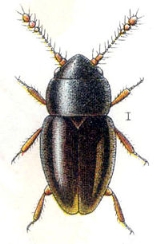
Ptiliidae
Encyclopedia
Ptiliidae is a family
of very tiny beetle
s with a worldwide distribution. This family contains the smallest of all beetles, with a length of 0.5 mm, and even the largest members of the family do not exceed 2 mm. The weight is approximately 0.4 milligrams.
They are colloquially called feather-winged beetles, as the hindwings
are narrow and feather-like. The obsolete name Trichopterygidae literally means "the hair-winged ones".
There are some 630 described species
in about 85 genera
, but large numbers of specimens in collections await description and the true number of species is clearly much higher than this. The Ptiliidae are divided into 5 subfamilies:
The Ptiliinae is the largest of these; over half of the described genera belong there.
Adults and larva
e are usually found in rotting organic material in a wide range of habitats. The eggs
are very large in comparison to the adult female (maybe half the length) so only one egg at a time can be developed and laid. Parthenogenesis
is exhibited by several species.
Fossil ptiliids have been recorded from the Oligocene
, roughly 30 million years ago. Some subfossil
specimens are also known from the Holocene
, but such remains are usually from species that still exist today.
Family (biology)
In biological classification, family is* a taxonomic rank. Other well-known ranks are life, domain, kingdom, phylum, class, order, genus, and species, with family fitting between order and genus. As for the other well-known ranks, there is the option of an immediately lower rank, indicated by the...
of very tiny beetle
Beetle
Coleoptera is an order of insects commonly called beetles. The word "coleoptera" is from the Greek , koleos, "sheath"; and , pteron, "wing", thus "sheathed wing". Coleoptera contains more species than any other order, constituting almost 25% of all known life-forms...
s with a worldwide distribution. This family contains the smallest of all beetles, with a length of 0.5 mm, and even the largest members of the family do not exceed 2 mm. The weight is approximately 0.4 milligrams.
They are colloquially called feather-winged beetles, as the hindwings
Insect wing
Insects are the only group of invertebrates known to have evolved flight. Insects possess some remarkable flight characteristics and abilities, still far superior to attempts by humans to replicate their capabilities. Even our understanding of the aerodynamics of flexible, flapping wings and how...
are narrow and feather-like. The obsolete name Trichopterygidae literally means "the hair-winged ones".
There are some 630 described species
Species
In biology, a species is one of the basic units of biological classification and a taxonomic rank. A species is often defined as a group of organisms capable of interbreeding and producing fertile offspring. While in many cases this definition is adequate, more precise or differing measures are...
in about 85 genera
Genera
Genera is a commercial operating system and development environment for Lisp machines developed by Symbolics. It is essentially a fork of an earlier operating system originating on the MIT AI Lab's Lisp machines which Symbolics had used in common with LMI and Texas Instruments...
, but large numbers of specimens in collections await description and the true number of species is clearly much higher than this. The Ptiliidae are divided into 5 subfamilies:
- Acrotrichinae
- Cephaloplectinae
- Limulodinae
- Nanosellinae
- PtiliinaePtiliinaePtiliinae is the largest subfamily of feather-winged beetles . About 80% of the described genera of these very tiny beetles are contained herein; however, many more genera and species await description....
The Ptiliinae is the largest of these; over half of the described genera belong there.
Adults and larva
Larva
A larva is a distinct juvenile form many animals undergo before metamorphosis into adults. Animals with indirect development such as insects, amphibians, or cnidarians typically have a larval phase of their life cycle...
e are usually found in rotting organic material in a wide range of habitats. The eggs
Egg (biology)
An egg is an organic vessel in which an embryo first begins to develop. In most birds, reptiles, insects, molluscs, fish, and monotremes, an egg is the zygote, resulting from fertilization of the ovum, which is expelled from the body and permitted to develop outside the body until the developing...
are very large in comparison to the adult female (maybe half the length) so only one egg at a time can be developed and laid. Parthenogenesis
Parthenogenesis
Parthenogenesis is a form of asexual reproduction found in females, where growth and development of embryos occur without fertilization by a male...
is exhibited by several species.
Fossil ptiliids have been recorded from the Oligocene
Oligocene
The Oligocene is a geologic epoch of the Paleogene Period and extends from about 34 million to 23 million years before the present . As with other older geologic periods, the rock beds that define the period are well identified but the exact dates of the start and end of the period are slightly...
, roughly 30 million years ago. Some subfossil
Subfossil
Subfossil refers to remains whose fossilization process is not complete, either for lack of time or because the conditions in which they were buried were not optimal for fossilization....
specimens are also known from the Holocene
Holocene
The Holocene is a geological epoch which began at the end of the Pleistocene and continues to the present. The Holocene is part of the Quaternary period. Its name comes from the Greek words and , meaning "entirely recent"...
, but such remains are usually from species that still exist today.

